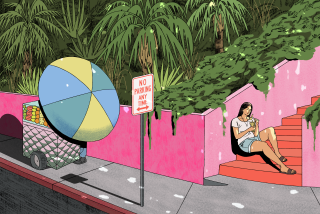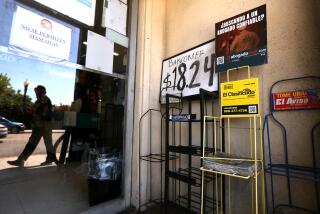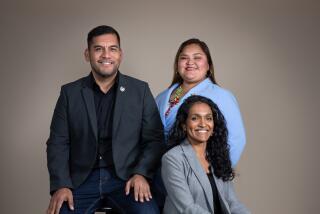What’s left of L.A.’s left?
IT WAS A LITTLE like Pravda running an expose on Lenin’s sex life, or the Wall Street Journal editorializing on the fetishes of conservative economist Friedrich Hayek. Three weeks ago, the L.A. Weekly, once the most reliably left-wing publication in the city, published a cover story all but alleging that the late union chief Miguel Contreras died in a brothel in South L.A.
But the story itself wasn’t as shocking as the fact that it was published at all in Los Angeles, let alone in the Weekly. Its publication was a sign not only that things have changed at the alternative paper but that this city’s intellectual climate has shifted.
For most of the last generation, L.A.’s public intellectual life has been dominated by editors, thinkers and writers who ran the ideological gamut from A to B -- from committed liberal to strident leftist. But in the last few years, as the Labor Left has consolidated its control over City Hall, it has simultaneously lost its firm grip on the small class of writers and thinkers who narrate L.A.’s civic life for the broader public.
Remember the early 1990s, after the city had self-destructed and a Republican mayor presided? Back then, Marxist apocalypticist Mike Davis ruled the intellectual roost and attained cult-like status. It’s not that everyone agreed with Davis’ dark millenarian vision, but few challenged him publicly in part because his zealous followers bullied dissenters. Anyone to the right of Friedrich Engels was labeled a fascist and risked personal attacks. The despair in the wake of the riots had made left-wing noir all the rage, and, as historian Kevin Starr once quipped, for a brief moment in L.A., pessimism passed for deep thought.
The mid-1990s brought a resurgence of a more traditional -- and constructive -- brand of intellectual leftism. Mostly through the voice of its former executive editor and chief political columnist, Harold Meyerson, the L.A. Weekly became the house organ for an emerging Latino-labor-left political coalition. The paper simultaneously narrated and championed a series of political milestones -- the election of Antonio Villaraigosa and Gil Cedillo to the state Assembly in 1994 and 1998, respectively, and the elevation of Contreras to head of the L.A. County Federation of Labor in 1996.
And it wasn’t alone. Although not as strident, The Times’ editorial page was also sympathetic to the rise of labor -- and was generally perceived as socially and fiscally liberal.
If the Davis crew endorsed cultish devotion to one individual, the rest of the intellectual left steamrolled dissent through its momentum and an aura of inevitability. The few naysaying opposition voices, such as Jill Stewart, then a columnist at the now defunct New Times L.A., and economics writer Joel Kotkin were written off as contemptuous right-wing renegades. And indeed, they were angry, indignant and downright screechy voices that tried to poke holes in the common wisdom. Yet only in L.A. could these disgruntled Democrats be considered right-wingers.
Then, depending on how you see it, in 1999 Davis was either run out of town by an overzealous fact-checker who questioned his credibility (especially in his book “City of Quartz”) or he just naturally morphed into his rightful place as a global writer with a consequently waning influence in L.A. Two years later, Meyerson moved to Washington to edit the liberal opinion journal the American Prospect. In the span of two years, L.A. lost its most prominent liberal and left-wing narrators.
“That part of the left had basically gone away,” said Loyola Marymount political scientist Fernando Guerra, “and there was no one of comparable stature to take their place.”
In the next few years, the hiring of new editorial page editors at The Times and a shift in ownership at the Weekly heralded a new era. In 2004, then-Times Opinion Editor Michael Kinsley was looking to break with the editorial page’s past. Under Kinsley hire Andres Martinez, the editorial page remains reliably liberal on social issues but more fiscally conservative and pro-business than in the past. In the 2005 special election, for example, the paper backed a “paycheck protection” ballot initiative that sought to minimize the power of public employee unions.
The next year, the New Times Media chain of weekly papers, based in Phoenix, merged with Village Voice Media, which owned the L.A. Weekly, and began to remake the paper in its image. Known for its anti-PC irreverence and old-fashioned muckraking, the editorial leadership of New Times is now pushing the Weekly toward hard news and away from liberal advocacy. Two weeks ago, Stewart was hired to supervise local news coverage.
But ironically, the most decisive blow to the dominance of L.A.’s intellectual left came in 2005 with Villaraigosa’s commanding victory over James K. Hahn in the mayoral race. A symbol of the triumphant left, Villaraigosa’s mayoralty posed a dilemma to local liberal writers who were used to seeing themselves as aligned with an embattled and insurgent movement. After one of their own ascended to the top of local politics, the movement’s discipline and unity naturally dissipated.
“Consolidation is inherently less exciting and uplifting than the sweep into power,” Meyerson said. “You’re not involved with just your own agenda anymore but with all sorts of agendas. There’s a different feeling in the city now.”
Left-wing intellectuals who were used to the L.A. Weekly being a loyal ally cried foul at the Contreras story. In an angry letter, Meyerson cut all remaining ties to the paper and lamented the fact that the Weekly no longer saw its “mission as fostering a particular kind of political, social and economic change in Los Angeles.”
Conspiracy theorists are likely to blame this intellectual shift on the absentee landlords who own the Weekly and The Times. Maybe they’d even call it a conservative backlash. But although there has been a slight movement to the right in the city’s public intellectual climate, the change is more about stridency, relative openness and tone than it is about ideology.
“Journalists in L.A. are starting to realize that all the leading local institutions are controlled by liberal Democrats, and they have to write about them critically too,” Stewart said.
The truth is that the intellectual climate is more open than it was a decade ago, more points of view and shades of gray are on the table, and demands for ideological loyalty have subsided. This is not to say that Los Angeles is no longer a liberal city. It is, but the rules of engagement have clearly shifted.
“Our beliefs probably haven’t changed,” said writer and poet D.J. Waldie, “but we do seem to have learned the language of compromise. Or maybe forces are emerging in L.A. that can’t be so easily identified as left or right, red or blue.”
Wouldn’t that be revolutionary?
More to Read
Sign up for Essential California
The most important California stories and recommendations in your inbox every morning.
You may occasionally receive promotional content from the Los Angeles Times.










